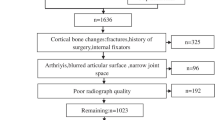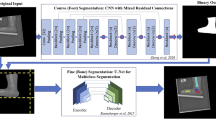Abstract
Objectives
Diagnosis of flatfoot using a radiograph is subject to intra- and inter-observer variabilities. Here, we developed a cascade convolutional neural network (CNN)–based deep learning model (DLM) for an automated angle measurement for flatfoot diagnosis using landmark detection.
Methods
We used 1200 weight-bearing lateral foot radiographs from young adult Korean males for the model development. An experienced orthopedic surgeon identified 22 radiographic landmarks and measured three angles for flatfoot diagnosis that served as the ground truth (GT). Another orthopedic surgeon (OS) and a general physician (GP) independently identified the landmarks of the test dataset and measured the angles using the same method. External validation was performed using 100 and 17 radiographs acquired from a tertiary referral center and a public database, respectively.
Results
The DLM showed smaller absolute average errors from the GT for the three angle measurements for flatfoot diagnosis compared with both human observers. Under the guidance of the DLM, the average errors of observers OS and GP decreased from 2.35° ± 3.01° to 1.55° ± 2.09° and from 1.99° ± 2.76° to 1.56° ± 2.19°, respectively (both p < 0.001). The total measurement time decreased from 195 to 135 min in observer OS and from 205 to 155 min in observer GP. The absolute average errors of the DLM in the external validation sets were similar or superior to those of human observers in the original test dataset.
Conclusions
Our CNN model had significantly better accuracy and reliability than human observers in diagnosing flatfoot, and notably improved the accuracy and reliability of human observers.
Key Points
• Development of deep learning model (DLM) that allows automated angle measurements for landmark detection based on 1200 weight-bearing lateral radiographs for diagnosing flatfoot.
• Our DLM showed smaller absolute average errors for flatfoot diagnosis compared with two human observers.
• Under the guidance of the model, the average errors of two human observers decreased and total measurement time also decreased from 195 to 135 min and from 205 to 155 min.





Similar content being viewed by others
Data availability
The dataset of the Military Manpower Administration and our institution cannot be disclosed due to the National Personal Information Protection Act. However, the Lower Extremity RAdiographs (LERA) dataset is publicly available. The codes are available. (https://github.com/kevinkwshin/FlatNet).
Abbreviations
- AUROC:
-
Area under the receiver operating characteristic curve
- CNN:
-
Convolutional neural network
- CPA:
-
Calcaneal pitch angle
- DLM:
-
Deep learning model
- GP:
-
General physician
- GT:
-
Ground truth
- ICC:
-
Intraclass correlation coefficient
- LERA:
-
Lower Extremity Radiographs (public dataset)
- MMA:
-
Military Manpower Administration
- OS:
-
Orthopedic surgeon
- SD:
-
Standard deviation
- TCA:
-
Talocalcaneal angle
- TMA:
-
Talo-first metatarsal angle
References
Lee MS, Vanore JV, Thomas JL et al (2005) Diagnosis and treatment of adult flatfoot. J Foot Ankle Surg 44:78–113
Walters JL, Mendicino SS (2014) The flexible adult flatfoot: anatomy and pathomechanics. Clin Podiatr Med Surg 31:329–336
Rose GK, Welton EA, Marshall T (1985) The diagnosis of flat foot in the child. J Bone Joint Surg Br 67:71–78
Harris EJ, Vanore JV, Thomas JL et al (2004) Diagnosis and treatment of pediatric flatfoot. J Foot Ankle Surg 43:341–373
Kliegman B (2011) Nelson textbook of pediatrics, 19th edn. Elsevier, Philadelphia, pp 2335–2344
Pfeiffer M, Kotz R, Ledl T, Hauser G, Sluga M (2006) Prevalence of flat foot in preschool-aged children. Pediatrics 118:634–639
Simkin A, Leichter I, Giladi M, Stein M, Milgrom C (1989) Combined effect of foot arch structure and an orthotic device on stress fractures. Foot Ankle 10:25–29
Tomaru Y, Kamada H, Tsukagoshi Y et al (2019) Screening for musculoskeletal problems in children using a questionnaire. J Orthop Sci 24:159–165
Lee EC, Kim MO, Kim HS, Hong SE (2017) Changes in resting calcaneal stance position angle following insole fitting in children with flexible flatfoot. Ann Rehabil Med 41:257–265
Bok SK, Kim BO, Lim JH, Ahn SY (2014) Effects of custom-made rigid foot orthosis on pes planus in children over 6 years old. Ann Rehabil Med 38:369–375
Hohmann E, Myburgh J, Keough N, Tetsworth K, Glatt V (2019) Inter- and intraclass correlations for three standard foot radiographic measurements for plantar surface angles. Which measure is most reliable? Foot Ankle Surg 25:646–653
Shelton TJ, Singh S, Bent Robinson E et al (2019) The influence of percentage weight-bearing on foot radiographs. Foot Ankle Spec 12:363–369
Tao X, Chen W, Tang K (2019) Surgical procedures for treatment of adult acquired flatfoot deformity: a network meta-analysis. J Orthop Surg Res 14:62
Abousayed MM, Alley MC, Shakked R, Rosenbaum AJ (2017) Adult-acquired flatfoot deformity: etiology, diagnosis, and management. JBJS Rev 5:e7
Gould N (1982) Graphing the adult foot and ankle. Foot Ankle 2:213–219
Davids JR, Gibson TW, Pugh LI (2005) Quantitative segmental analysis of weight-bearing radiographs of the foot and ankle for children: normal alignment. J Pediatr Orthop 25:769–776
Steel MW 3rd, Johnson KA, DeWitz MA, Ilstrup DM (1980) Radiographic measurements of the normal adult foot. Foot Ankle 1:151–158
Aronson J, Nunley J, Frankovitch K (1983) Lateral talocalcaneal angle in assessment of subtalar valgus: follow-up of seventy Grice-Green arthrodeses. Foot Ankle 4:56–63
Okuda R, Kinoshita M, Yasuda T, Jotoku T, Kitano N, Shima H (2007) The shape of the lateral edge of the first metatarsal head as a risk factor for recurrence of hallux valgus. J Bone Joint Surg Am 89:2163–2172
Lee KT, Kim KC, Park YU, Kim TW, Lee YK (2011) Radiographic evaluation of foot structure following fifth metatarsal stress fracture. Foot Ankle Int 32:796–801
Kido M, Ikoma K, Ikeda R et al (2020) Reproducibility of radiographic methods for assessing longitudinal tarsal axes Part 2: Severe cavus or flatfoot study. Foot (Edinb) 42:101631
Bock P Pittermann M Chraim M Rois S (2018) The inter- and intraobserver reliability for the radiological parameters of flatfoot, before and after surgery. Bone Joint J 100-B 596–602
Kao EF, Lu CY, Wang CY, Yeh WC, Hsia PK (2018) Fully automated determination of arch angle on weight-bearing foot radiograph. Comput Methods Programs Biomed 154:79–88
Kim IH, Kim YG, Kim S, Park JW, Kim N (2021) Comparing intra-observer variation and external variations of a fully automated cephalometric analysis with a cascade convolutional neural net. Sci Rep 11:7925
Kim J, Kim I, Kim YJ et al (2021) Accuracy of automated identification of lateral cephalometric landmarks using cascade convolutional neural networks on lateral cephalograms from nationwide multi-centres. Orthod Craniofac Res 24(Suppl 2):59–67
Guo J, Mu Y, Xue D et al (2021) Automatic analysis system of calcaneus radiograph: Rotation-invariant landmark detection for calcaneal angle measurement, fracture identification and fracture region segmentation. Comput Methods Programs Biomed 206:106124
Yang W, Ye Q, Ming S et al (2020) Feasibility of automatic measurements of hip joints based on pelvic radiography and a deep learning algorithm. Eur J Radiol 132:109303
Ryu SM, Shin K, Shin SW et al (2022) Automated landmark identification for diagnosis of the deformity using a cascade convolutional neural network (FlatNet) on weight-bearing lateral radiographs of the foot. Comput Biol Med 148:105914
Dutta A, Zisserman A (2019) The VIA annotation software for images, audio and video proceedings of the 27th ACM International Conference on Multimedia, 2276 2279
Varma M, Lu M, Gardner R et al (2019) Automated abnormality detection in lower extremity radiographs using deep learning. Nat Mach Intell 1:578–583
Delong ER, Delong DM, Clarkepearson DI (1988) Comparing the areas under 2 or more correlated receiver operating characteristic curves - a nonparametric approach. Biometrics 44:837–845
Bland JM, Altman DG (1996) Measurement error and correlation coefficients. BMJ 313:41–42
Flores DV, Mejia Gomez C, Fernandez Hernando M, Davis MA, Pathria MN (2019) Adult acquired flatfoot deformity: anatomy, biomechanics, staging, and imaging findings. Radiographics 39:1437–1460
DiGiovanni JE, Smith SD (1976) Normal biomechanics of the adult rearfoot: a radiographic analysis. J Am Podiatry Assoc 66:812–824
Koo TK, Li MY (2016) A guideline of selecting and reporting intraclass correlation coefficients for reliability research. J Chiropr Med 15:155–163
Muller R, Buttner P (1994) A critical discussion of intraclass correlation coefficients. Stat Med 13:2465–2476
Liljequist D, Elfving B, Roaldsen KS (2019) Intraclass correlation – A discussion and demonstration of basic features. PLoS One 14(7):e0219854. https://doi.org/10.1371/journal.pone.0219854
Regulation Army (2004) Standards of medical fitness. Headquarters, Department of the Army Washington, DC
Ryu SM, Lee TK, Lee SH (2022) Prevalence of flatfoot among young Korean males and the correlation among flatfoot angles measured in weight-bearing lateral radiographs. Medicine (Baltimore) 101(30):e29720. https://doi.org/10.1097/MD.0000000000029720
Yang C-H, Chou K-T, Chung M-B, Chuang KS, Huang T-C (2015) Automatic detection of calcaneal-fifth metatarsal angle using radiograph: a computer-aided diagnosis of flat foot for military new recruits in Taiwan. PLoS One 10(6):e0131387. https://doi.org/10.1371/journal.pone.0131387
Winklhofer S, Berger N, Ruder T et al (2014) Cardiothoracic ratio in postmortem computed tomography: reliability and threshold for the diagnosis of cardiomegaly. Forensic Sci Med Pathol 10:44–49
Fernandezfeliberti R, Flynn J, Ramirez N, Trautmann M, Alegria M (1995) Effectiveness of Tlso bracing in the conservative treatment of idiopathic scoliosis. J Pediatr Orthop 15:176–181
Robinson AHN, Limbers JP (2005) Modern concepts in the treatment of hallux valgus. J Bone Joint Surg Br 87b:1038–1045
Acknowledgements
We thank Dr. Joon Seo Lim from the Scientific Publications Team at Asan Medical Center for his assistance with English language editing and preparing this manuscript.
We also thank Inhwan Kim for his contribution to the python code of deep learning model development.
Funding
This research was supported by Basic Science Research Program through the National Research Foundation of Korea (NRF) funded by the Ministry of Education. (2021R1A6A3A01088445).
Author information
Authors and Affiliations
Corresponding author
Ethics declarations
Guarantor
The scientific guarantor of this publication is Seung Min Ryu from the University of Ulsan College of Medicine and Namkug Kim from Asan Medical Center.
Conflict of interest
The authors of this manuscript declare no relationships with any companies whose products or services may be related to the subject matter of the article.
Statistics and biometry
The scientific guarantor of this publication is Min-Ju Kim from the University of Ulsan College of Medicine. No complex statistical methods were necessary for this paper.
Informed consent
This retrospective study was conducted according to the principles of the Declaration of Helsinki and in accordance with the current scientific guidelines. The research protocol was approved by the Institutional Review Board of our institution, which waived the requirement for informed consent considering the retrospective nature of the study and de-identification characteristics of the dataset, in accordance with the Health Insurance Portability and Accountability Act privacy rule. (S2021-0922-0001).
Ethical approval
This retrospective study was conducted according to the principles of the Declaration of Helsinki and in accordance with the current scientific guidelines. The research protocol was approved by the Institutional Review Board of our institution, which waived the requirement for informed consent considering the retrospective nature of the study and de-identification characteristics of the dataset, in accordance with the Health Insurance Portability and Accountability Act privacy rule. (S2021-0922–0001).
Methodology
-
retrospective
-
diagnostic or prognostic study
-
multicenter study
Additional information
Publisher's note
Springer Nature remains neutral with regard to jurisdictional claims in published maps and institutional affiliations.
Supplementary information
Below is the link to the electronic supplementary material.
Rights and permissions
Springer Nature or its licensor (e.g. a society or other partner) holds exclusive rights to this article under a publishing agreement with the author(s) or other rightsholder(s); author self-archiving of the accepted manuscript version of this article is solely governed by the terms of such publishing agreement and applicable law.
About this article
Cite this article
Ryu, S.M., Shin, K., Shin, S.W. et al. Automated diagnosis of flatfoot using cascaded convolutional neural network for angle measurements in weight-bearing lateral radiographs. Eur Radiol 33, 4822–4832 (2023). https://doi.org/10.1007/s00330-023-09442-1
Received:
Revised:
Accepted:
Published:
Issue Date:
DOI: https://doi.org/10.1007/s00330-023-09442-1




